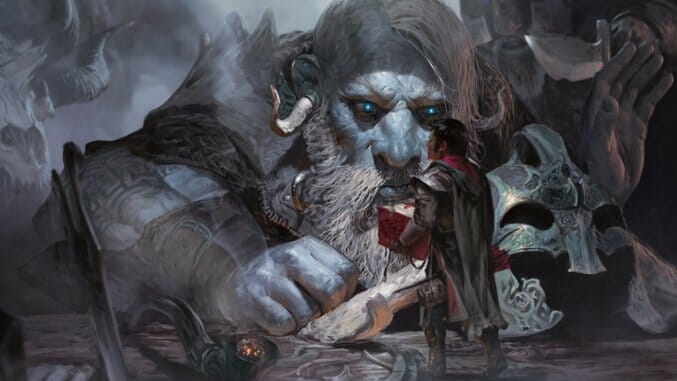Volo’s Guide to Monsters is the newest rulebook from Dungeons & Dragons, and it’s a damned good one. As I wrote in my preview of the book, the Volo of the title is one of the most interesting characters from the history of the game. He’s a point of view character who delivers information about the Forgotten Realms, its denizens, and the strange locations that dot the fantasy landscape that’s been in constant roiling development for thirty years.
Volo’s Guide to Monsters is split into three distinct sections. The first is a guidebook to certain creatures of the Forgotten Realms, and it contains a huge amount of information about the social structures, architectural styles, religions, personalities, and all kinds of other stuff of many different “monsters” that are familiar to D&D or fantasy fans. You can learn all about how giants organize their life by an “ordning” and what it means to be an independent spirit in giant society. You can also do a deep dive on kobolds and why they hate gnomes (it’s because the gnomish god Garl Glittergold trapped a kobold god in an unending maze).
This first half of the book functions as some scaffolding for a Dungeon Master to create adventures out of. It’s a rare D&D campaign that avoids monsters altogether, and it’s very easy as a DM to just say “here’s some mind flayers, they sure are mean, aren’t they?” The now-worn concept that “every villain is a hero of their own story” is really helpful for great storytelling, but it’s often hard to make those heroic stories without a structure of where the villains might come from.
Volo’s Guide to Monsters gives a creator the basic tools to determine that, say, the leader of the raiding gnoll party believes that he has been chosen by the demon lord Yeenoghu to eliminate humans from the valley. Worse yet, Yeenoghu has sent that vision to dozens of gnoll leaders (because that’s just how he is). Chaos ensues, but it’s predictable and investigable chaos that makes for engaging and exciting situations for players to be in.
The second section of the book includes statistics and rules for additional races (I always prefer “species” here) that players in your Dungeons & Dragons campaign could roleplay as. Aasimar, kenku, goliaths and a few others make up the thirteen new 5th Edition species. The most I have to say about this is that you should definitely play the kenku. It’s a cool crow-person who hollers and squawks and generally just owns bones all over the Forgotten Realms.
The last third of the book is a more traditional bestiary that you might be familiar with in the form of the many Monster Manuals across the different editions of D&D. It’s a list of monsters, a block of statistics about them, and some basic explanatory segments about how they live in the world. You’re not getting the deep, contextualized information that exists in the opening of Volo’s Guide to Monsters, but these are mostly creatures that don’t need it. The froghemoth, which is “an amphibious predator as big as an elephant,” doesn’t really need a longform explanation of its religious beliefs. It’s a froghemoth. It does what it says on the label.
I will say that the creatures in the Guide are generally more interesting and useful to me as a Dungeon Master than the ones in the original Monster Manual for 5th edition. Those original monsters were staples, but as a DM I could generally figure out what staples were supposed to do on my own. Volo’s Guide has creatures I would never think of, let alone know how to properly “create” in the context of D&D. I would never invent the flail snail, the banderhobb, or the morkoth. They’re all super weird, and I’m glad that this guide book is leaning into those stranger parts of the Forgotten Realms’s ecosystem.
My one serious critique of Volo’s Guide to Monsters is that it doesn’t do enough with its supposed writer. The character Volo has done a number of things: he wrote guides to specific cities, appeared in games, and even wrote the manual for a Baldur’s Gate game. He’s a deeply subjective character who is a bit of a coward, a serious lover of food, and a dude who really likes to talk about himself. He’s got a very specific way of looking at the world, and if I flip open my Volo’s Guide to Waterdeep, I can learn about a tavern in that city called The Misty Beard. “The garlic butter is justly famous, and a wonderful gooseberry jam is made on the premises,” Volo writes. Notice that this is pure opinion without an ounce of claim to fact—Volo likes a jam! Everything in that book is written in that way, and you know that you’re getting a view of the world without any claims to objectivity. Volo’s Guide to Monsters has snippets of info from Volo, but it mostly tells the DM facts about a world, rather than opinions, rumors and suspicions that might be completely unfounded. It’s a small complaint, but I feel like Volo as a character who tells you about one slice of the world might be completely eliminated at this point, and that makes me sad.
In any case, the book is interesting and genuinely helpful for any given Dungeon Master who might be using these monsters in her campaign. It might also be a great gift for any given person who wants to read about interesting world and monster design.
Cameron Kunzelman tweets at @ckunzelman and writes about games at thiscageisworms.com. His latest game, Epanalepsis, was released last year. It’s available on Steam.
